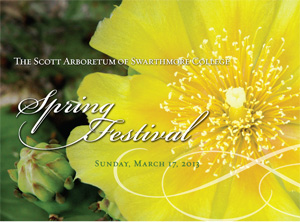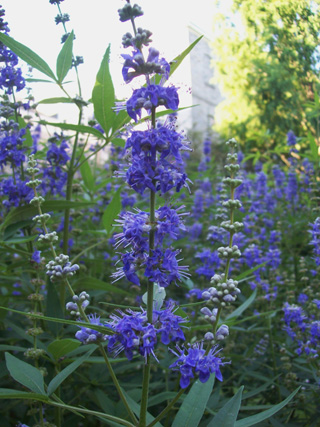Vitex agnus-castus ‘Shoal Creek’
 By Josh Coceano and Becky Robert
By Josh Coceano and Becky Robert
At the Arboretum, we are already in the flurry of spring and spring activities including the celebration of the Spring Festival. At this annual membership event, we will distribute the spring plant dividend including Vitex agnus-castus ‘Shoal Creek’.

Ranked second best blue Vitex by Longwood Garden trials, Vitex agnus-castus 'Mississippi Blues'. photo credit: J. Coceano
Vitex, commonly known as chaste tree, is a large shrub in the greater Philadelphia gardening area. Over the past several years, Longwood Gardens has been trialing approximately 250 species of this genus in search of plants that are attractive and drought-tolerant for our ever hotter, drier climate.
Originally introduced by Goodness Grows Inc. of Lexington, GA in 1983, Vitex agnus-castus ‘Shoal Creek’ was selected for its vigorous habit, large lilac-like flower spikes, bluer blooms, and high leafspot resistance. ‘Shoal Creek’ was clearly the best blue-flower in the Longwood trials along with a good rating for fall display of attractive seed heads. It was noted that the young stems are a flashy purple in spring turning red-brown in winter.
Aromatic leaves of V. ‘Shoal Creek’ are composed of five to seven digitate leaflets. In June and July, 12”-18” panicles of lavender-purple flowers cover the terminal ends of the branches. Deadheading spent flowers encourages rebloom.
Plant in full sun. While Vitex can reach upwards of 15’ in height, treating it as a cutback shrub allows for smaller heights to be maintained. Flowers appear on new wood. In severe winters plants may die to the ground, but are root hardy.

Enjoy champagne toast and hors d'oeuvres at the Spring Festival this Sunday. photo credit: A. Nelson
Join us at the Spring Festival on Sunday, March 17 to pick up your plant dividend, learn from our 2013 Scott Medal and Award winner John Fairey, and enjoy a champagne toast and hors d’oeuvres. In addition to a choice of V. ‘Shoal Creek, members can choose between four cultivars of brugmansias.





Jay Trolley
Posted at 05:38h, 16 MarchI have a small shaded property with one Vitex situated along a narrow driveway that gets a bit of sun. The bush has reached upwards to 15 feet when left without a good ‘trim’.
Both dividends this year will do better in the sun. Next year could you consider offering at least oone ‘shade’ dividend?